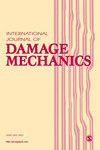A nonlinear fatigue damage accumulation model for rolling bearing life prediction considering coupled load-variation effects
IF 3.9
2区 工程技术
Q2 MATERIALS SCIENCE, MULTIDISCIPLINARY
引用次数: 0
Abstract
In practical engineering applications, rolling bearings and other critical components are typically subjected to complex, variable loading conditions. The coupled effects of load magnitude, frequency, and phase significantly accelerate the initiation and propagation of fatigue cracks. Although existing fatigue damage accumulation models partially account for load sequence and interaction, many of these models are overly complex and involve numerous parameters, making it challenging to strike a balance between accuracy and computational efficiency. To address this issue, this paper proposes a fatigue damage accumulation model based on nonlinear damage evolution theory, which simultaneously considers the effects of load interaction and material parameters under variable loading conditions. By incorporating the interaction factor and critical material parameters, the model more accurately characterizes the variations in load spectra and the differences in fatigue performance among different materials. Subsequently, the model was validated against cyclic loading test data for 16Mn steel, hot-rolled 16Mn steel, 30NiCrMoV12 steel, Ti–6Al–4V titanium alloy, GS-61 steel, Al2024–T42 aluminum alloy, C45 steel, Q235B steel, and Al6082–T6 aluminum alloy. Comparative analyses with the Miner rule, Manson–Halford model, Aeran's model, and its improved model demonstrated that the proposed model exhibits significant improvements in both predictive accuracy and generalization capability. Furthermore, to verify the model's applicability in real-world engineering environments, two rolling bearings subjected to variable operating conditions were selected for case studies. The results indicate that the model exhibits strong validity and applicability in fatigue life prediction, offering novel insights and methods for the safety assessment and life prediction of critical components subjected to complex loading spectra.考虑耦合载荷变化影响的滚动轴承寿命预测非线性疲劳损伤累积模型
在实际工程应用中,滚动轴承和其他关键部件通常受到复杂的,可变的加载条件。载荷幅值、频率和相位的耦合效应显著加速了疲劳裂纹的萌生和扩展。尽管现有的疲劳损伤累积模型在一定程度上考虑了载荷序列和相互作用,但许多模型过于复杂,涉及的参数众多,很难在精度和计算效率之间取得平衡。针对这一问题,本文提出了一种基于非线性损伤演化理论的疲劳损伤累积模型,该模型同时考虑了变载荷条件下载荷相互作用和材料参数的影响。该模型通过纳入相互作用因子和关键材料参数,更准确地表征了不同材料之间载荷谱的变化和疲劳性能的差异。随后,通过16Mn钢、热轧16Mn钢、30NiCrMoV12钢、Ti-6Al-4V钛合金、GS-61钢、Al2024-T42铝合金、C45钢、Q235B钢和Al6082-T6铝合金的循环加载试验数据对模型进行验证。与Miner规则、Manson-Halford模型、Aeran模型及其改进模型的对比分析表明,该模型在预测精度和泛化能力方面均有显著提高。此外,为了验证该模型在实际工程环境中的适用性,选择了两个处于可变工况的滚动轴承进行案例研究。结果表明,该模型在疲劳寿命预测中具有较强的有效性和适用性,为复杂载荷谱下关键部件的安全评估和寿命预测提供了新的思路和方法。
本文章由计算机程序翻译,如有差异,请以英文原文为准。
求助全文
约1分钟内获得全文
求助全文
来源期刊

International Journal of Damage Mechanics
工程技术-材料科学:综合
CiteScore
8.70
自引率
26.20%
发文量
48
审稿时长
5.4 months
期刊介绍:
Featuring original, peer-reviewed papers by leading specialists from around the world, the International Journal of Damage Mechanics covers new developments in the science and engineering of fracture and damage mechanics.
Devoted to the prompt publication of original papers reporting the results of experimental or theoretical work on any aspect of research in the mechanics of fracture and damage assessment, the journal provides an effective mechanism to disseminate information not only within the research community but also between the reseach laboratory and industrial design department.
The journal also promotes and contributes to development of the concept of damage mechanics. This journal is a member of the Committee on Publication Ethics (COPE).
 求助内容:
求助内容: 应助结果提醒方式:
应助结果提醒方式:


